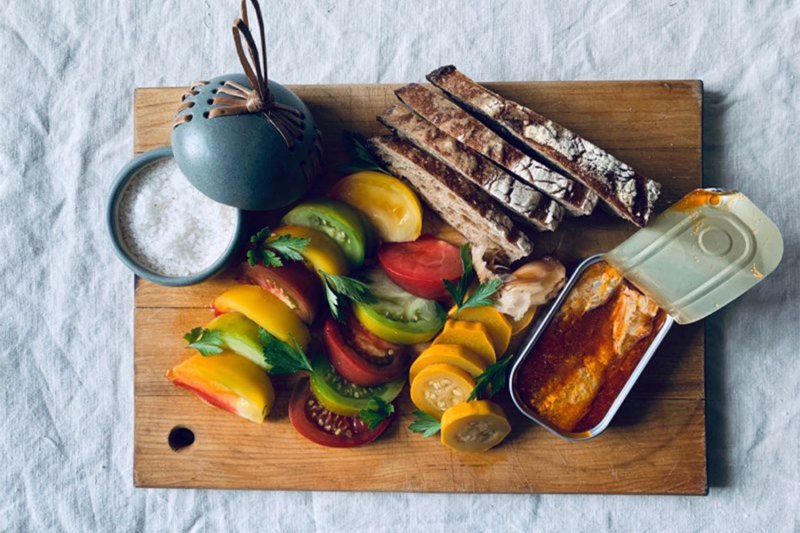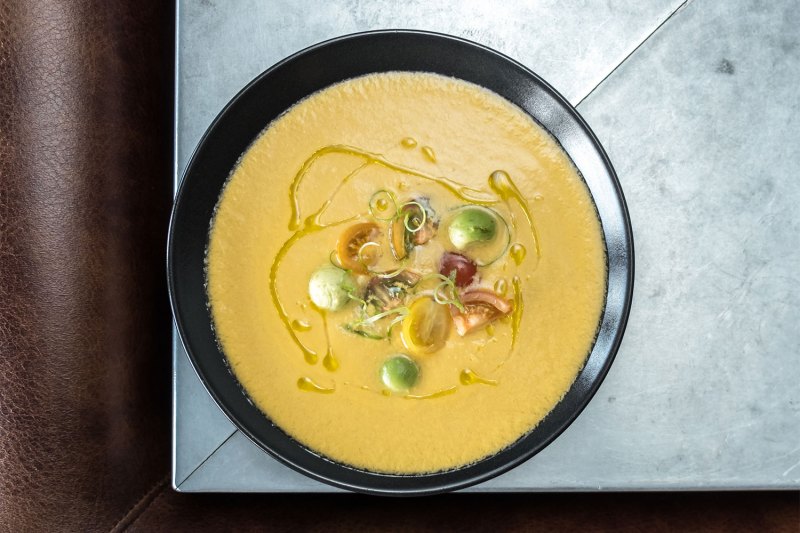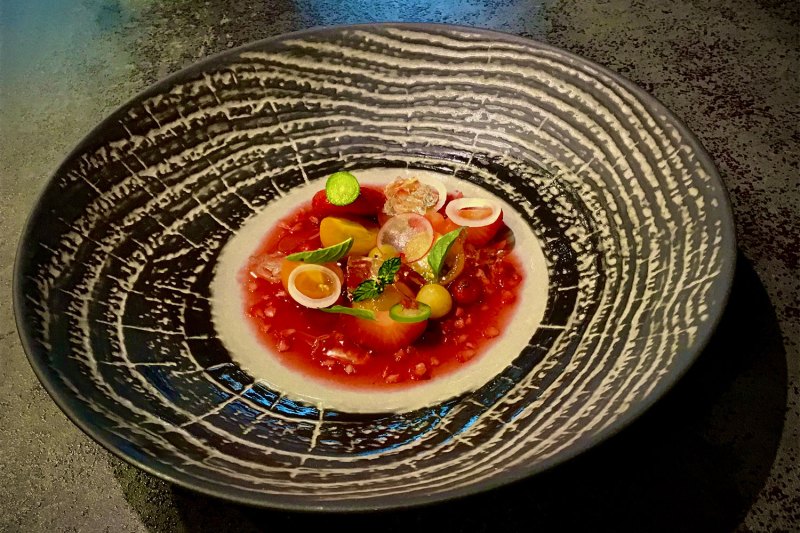When you walk up to a farmer’s market stand on a late summer day, ready to spend some cash on freshly-grown produce, you’ll surely notice no shortage of in-season veggies on display — everything from greens to herbs to squash to corn. But the hottest sellers, the items that attract the biggest crowds and the most attention, will undoubtedly come in the form of plump, juicy, colorful heirloom tomatoes.
Heirloom tomatoes pop up on seasonal menus throughout the summer, often to enormous acclaim from critics and diners alike. But what is so special about this particular nightshade? What sets heirloom tomatoes apart from their regular mass-market equivalents? Our curiosity led us to consult both professional gardeners and chefs who frequently work with heirlooms to get the full scoop on what makes these tomatoes stand out and to learn the best ways to enjoy them before their all-too-brief season ends.
What is an heirloom tomato?
“The term ‘heirloom’ means that the seed has been passed down from generation to generation, so that the plant can be grown year after year. Some of these seeds are over 200 years old,” executive chef Andy Clark of Napoli Pasta Bar in Washington, D.C. offers up as a quick explanation of this descriptor. While all heirloom tomatoes come from seeds harvested from the best tomato plants of past seasons, Clark does offer a few words of caution to anyone assuming that an ‘heirloom’ label automatically equals a great tomato: “If an heirloom tomato is treated with chemicals to extend its shelf life and keep insects off of it, then you have a whole different tomato. There are very few places where you can actually buy true heirlooms. I get all mine from farms that I can trust, where I know their growing practices. I’d suggest looking at farmer’s markets; they are the best places for non-chefs to get their hands on the same product that we get to use.”
Gardening expert Derek Gaughan of Prince Gardening advises heirloom tomato shoppers to let go of “perfect” aesthetic expectations, agreeing that trusted farmer’s markets and CSAs are the places to find the best possible versions of these fruits: “Generally, heirloom tomatoes are ‘ugly.’ You will often see large bumps, deep rooted stems, and a wide array of colors. The skin of heirlooms tend to be much thinner than hybrid tomatoes, which means they can spoil quicker. However, these characteristics are not always a guarantee you have a juicy heirloom. Try to find a farmer at your local farmer’s market that you can trust. This is someone who is more than willing to tell you everything they know about how the tomato was grown and why they designate it an heirloom. I also strongly recommend signing up with a local CSA — not only do you support local farmers but it also gives you the opportunity to cook with a wide variety of unique foods local to your region.”
In terms of flavor, what can you anticipate from a prime batch of heirlooms? “There are few things in this world that taste exactly like summer the way heirloom tomatoes do. You taste the rain of April and May that pushed those little buds to swell like the water balloons you threw at your neighbors. You taste the hot sun that tanned the skin to all shades of reds, greens, and yellows. And mostly, you taste the sweet, savory, sour, umami flavors so primary [and] so essential that entire cuisines across the world from each other are based around them,” effuses executive sous chef Bradley Hoffman of L.A. Jackson in Nashville.
How do heirloom tomatoes differ from “regular” (hybrid) tomatoes?
“If the term ‘regular’ refers to grocery store tomatoes, [then] they are commercially grown,” explains horticulturist Stephanie Tittle of Barn8 Restaurant & Bourbon Bar in Goshen, Kentucky. “Most commercially grown — mass-produced — tomatoes are hybrids that have been grown for a specific characteristic like thicker skin, which makes them easy to harvest and ship. These tomatoes are often harvested and shipped green. Heirloom tomatoes, on the other hand, have not been cross [bred] and will come true from seed season to season, if you take the time to save [the seeds]. These varieties are often thin-skinned, richer in flavor, and come in a wide variety of shapes and colors.”
Founder Christy Wilhelmi of Gardenerd gives the following advice to heirloom tomato novices hoping to score the best versions: “The word ‘heirloom’ simply means something that’s been handed down from generation to generation. There are heirloom beefsteaks, heirloom plum, paste, salad-sized, and cherry tomatoes. The term means more to gardeners than to shoppers, since it indicates that the seeds from an heirloom tomato can be saved and grown out again. The result will be a plant that produces fruit just like its parent. Modern hybrids are bred to look like old fashioned heirlooms but the seeds will not breed true to type — they won’t grow out to look and taste like their parents. As far as shoppers are concerned, the word ‘heirloom’ usually evokes a big, rainbow-colored beefsteak to them. Unless they know the names of the heirlooms they want to buy, shoppers will probably not be able to tell the difference. Just know that tomatoes grown for markets are bred to be shelf-stable, durable for transport, and weigh a lot to fetch a higher price. Home-grown heirlooms may not stand up to those three elements as well, but they are by far superior in flavor.”
Are all heirloom tomatoes organic?
It’s easy to assume that all heirloom tomatoes meet the “organic” standard, especially since they’re frequently found at farmer’s markets and in specialty grocery stores like Whole Foods. However, Stephanie Tittle cautions that “it’s important to not confuse heirloom with organic, and organic with zero pesticide application. Just because someone grows heirloom varieties does not mean they use organic practices. Further, just because someone uses organic practices does not mean they do not spray pesticides. Get to know your farmer and ask them what varieties they are growing and if that variety is an heirloom. There are so many tomatoes out there and people’s taste preferences are so broad. I advise you to taste them all! Remember, pretty doesn’t always mean tasty.”
Is it more difficult to grow heirloom tomatoes than regular ones?
If you’d like to give heirloom tomatoes a whirl during your next summer gardening season, it’s crucial to start your planning in the near future, since heirloom tomatoes rely on seeds harvested during peak tomato season (i.e. right now). Home gardener and recipe creator Laura Miner of Cook At Home Mom provided us with a basic guide to gathering heirloom seeds: “Just squeeze the seeds and juice of your best tomatoes into a cup or bowl and set it on a sunny windowsill or even outside for a few days. Scrape off any mold that grows (it’ll be white and is not cause for concern at all). After you scrape off the mold, very gently fill the container with water, stir, and set aside until seeds fall to the bottom. Drain the liquid and rinse the seeds gently a few times. Allow them to dry completely (this takes a few days) and store in a cool, dry place until you’re ready to start new tomato plants!”
If you’re a first-time tomato grower seeking to plant heirlooms, you should keep in mind that heirloom tomatoes have finicky tendencies, according to founder Shelby DeVore of Farminence: “Heirloom tomatoes are considered ‘picky.’ They may not have the disease, pest, and environmental resistance that many hybrid plants have. You’ll want to be extra diligent in taking care of your heirloom tomato plants. Keep the soil moisture as consistent as possible since many heirloom tomatoes have very thin skin. The thin skin makes them more prone to cracking, which occurs when the tomato plant gets too much water at one time. The extra water will also water the tomato down, diluting the flavor of the tomato.”
Gardener Jonathan Corey of Spork in Pittsburgh, Pennsylvania also encourages heirloom enthusiasts to be fastidious about pruning their plants and setting up garden infrastructures that enable quality growth. “The best piece of advice I could offer is to trellis the plants and prune regularly. Tomato cages, although easy, don’t really provide enough support. In addition, they can make pruning and the removal of suckers more difficult due to limited access. With a wire or string trellis, the plant can be continually supported along its stem where the weight of the fruit is carried. This also enables easy pruning, which is pivotal to maintaining healthy plants by keeping leaves off the ground and ensuring good airflow around them,” he says.
Peggy Cornett, the curator of plants at Monticello in Virginia, points out that heirloom tomatoes tend to be bountiful, and that you’ll want to prepare for large harvests: “Heirloom tomatoes can be prolific, so be aware of your space and ability to consume, preserve, and/or share with neighbors. Give the plants plenty of space for good air-circulation.”
What’s the best way to serve heirloom tomatoes?
When we asked our sources for their opinions on the absolute best ways to prepare and serve heirloom tomatoes, they overwhelmingly agreed that simplicity is the ideal approach. “Keep it simple. You don’t need anything more than fresh tomatoes and good sea salt,” insists chef Rob Guimond of Public Display of Affection in Brooklyn, New York.
As for chef Joe Natoli of Sawgrass Marriott Golf Resort & Spa in Ponte Vedra Beach, Florida, he tells us that there’s “nothing better than quartering an heirloom plum — such as the tiger blush — letting it bake in the sun until it almost caramelizes its own sugars, holding it in olive oil, and putting it on everything!”
Heirloom Tomatoes with Portuguese Sardines, Olive Oil and Bread
(By David Santos, chef, Um Segredo Supper Club, New York City)

For a serving strategy that allows heirloom tomatoes to claim the spotlight while also incorporating engaging flavors that complement the tomatoes’ natural sweetness and hearty texture, try this version by Chef David Santos, who tells us that “I am an advocate of serving the summer bounty of heirloom tomatoes quite simply with a couple of supporting actors to make it a meal.”
Ingredients:
- 2 large heirloom tomatoes
- 4-6 slices good bread, toasted
- 1 can good Portuguese sardines (Santos recommends Nuri sardines)
- .5 pickled summer squash or a local pickle of your choice
- Several sprigs of parsley
- Sea salt, to taste
- Extra virgin olive oil, to taste (Santos recommends Esporao extra virgin olive oil)
Method:
- Slice the tomatoes in half and cut out the core with a V cut. Slice the tomatoes from the center outward to form .25-inch wedges.
- Arrange the tomatoes on a board or large plate and sprinkle with a generous amount of sea salt and a good drizzle of olive oil.
- Serve with canned Portuguese sardines, bread, and pickles.
Golden Gazpacho
(By Rich Hinojosa, executive chef, CRUjiente Tacos, Phoenix, Arizona)

Gazpacho makes an excellent late-summer repast for a number of reasons, and this take on the Spanish classic, made with yellow heirloom tomatoes and served cold, proves both refreshing and flavorful.
Ingredients:
- 5 large yellow heirloom tomatoes, rinsed, stemmed, and quartered
- 2 medium sized English cucumbers, peeled and diced
- 1 small red onion, thinly sliced
- 1 large yellow bell pepper, seeded and finely diced
- 1 cup tomato water (or regular water)
- .25 cup olive oil
- .25 cup plus 3 tbsp Champagne vinegar
- 4 garlic cloves, crushed
- 3 tbsp salt
- .25 tsp cumin
- 2 tbsp plain yogurt
- 1 tbsp mayonnaise
- 12 grape tomatoes, rinsed and cut in half (for garnish)
- Thinly sliced scallions (for garnish)
- Avocado “melon balls” (for garnish)
Method:
- In a large non-reactive container, add heirloom tomatoes, cucumbers, red onion, yellow bell pepper, tomato water, olive oil, Champagne vinegar, garlic cloves, salt, and cumin. Cover tightly and let sit overnight.
- Stir the vegetables well, then add to a blender with plain yogurt and blend until smooth. Pour through a chinois or a strainer (not a very fine mesh one).
- Return the strained contents to the blender, add mayonnaise, and blend until smooth. Taste and season with salt and vinegar. Pour into a non-reactive container with a lid and store in the fridge until ready to serve.
- When it’s time to serve, ladle the gazpacho into a bowl and garnish with grape tomatoes, scallions, melon balls of avocado, and olive oil.
Heirloom Tomatoes With Salted Plum Broth, Tomato Honey, And Riesling Gelée
(By Nahid Ahmed and Arjuna Bull, chefs, Luthun, New York City)

“At Luthun, we are trying to make our dish taste like summer, so the heirloom tomatoes we use are a component of the dish and not necessarily the main ingredient. Our dish uses heirloom cherry tomatoes that are marinated in a tomato ‘honey’ that uses tomato trimmings, sugar, and lemon juice. To get that honey texture, you need to use some glucose, which you can get from the baking aisle at grocery stores. We then add some freeze-dried raspberries. For the right texture and temperature, we use liquid nitrogen to freeze them. You can just freeze them at home in your freezer and smash them for a similar effect. We use a Riesling gelée, which is Riesling, gelatin, sugar and lemon juice. This is reduced down a bit to reduce the alcohol, which adds a nice texture and sweetness. Because Riesling is such a floral grape, it fits well with the rose petals we use in the sauce. The sauce is made from fresh heirloom tomatoes, salted plums and rose petals, all blended together. [The dish] is then garnished with raw onions, bush basil, and Serrano pepper,” Chefs Nahid Ahmed and Arjuna Bull say of their more ambitious but equally tomato-forward recipe.
Ingredients:
Salted Plum Broth:
- 15 fresh plums
- 15 heirloom tomatoes
- 3 tbsp rice wine vinegar
- 4 oz of dried rose petals
- 2 tbsp sugar
- Salt, to taste
- .01% xanthum gum (check box instructions, because a little goes a long way)
- 2 tsp of rose water
- 2 tbsp rose syrup
- 1 pinch Kashmiri chili
Freeze-Dried Raspberries:
- 1 lb of fresh raspberries
- 1 tbsp sugar
- 1 pinch of Kashmiri chili
- Salt, to taste
Riesling Gelée:
- 1 bottle of Riesling (Ahmed and Bull prefer a Kabinett Riesling)
- 1 orange, juiced
- 1 cup simple syrup
- Salt, to taste
- 6 sheets gelatin
Tomato Honey:
- 10 medium-sized heirloom tomatoes, blanched, skins and seeds removed
- The zest and juice of 2 lemons
- 4 tbsp sugar
- Salt, to taste
- 6 tbsp glucose
Finished Dish:
- Heirloom cherry tomatoes, as many as you’d like
- Other summer fruits, like strawberries (optional)
Method:
- To make the freeze-dried raspberries, add the raspberries to a large bowl with sugar, chili, and salt. Toss until the berries are evenly coated.
- Put the bowl in the freezer and freeze for 6 hours.
- Put the frozen berries in a food processor and pulse until broken up.
- To make the salted plum broth, put the plums in a large bowl and add salt. Allow to sit for several hours until the plums fully absorb the salt.
- Add the plums, heirloom tomatoes, rice wine vinegar, rose petals, sugar, salt and xanthum gum to a saucepot and bring to a boil.
- Strain the liquid and add rose water, rose syrup and Kashmiri chili. Chill for at least 4 hours.
- To make the tomato honey, boil the blanched, peeled, and seeded tomatoes with the lemon zest, lemon juice, sugar, salt and glucose until the tomatoes are soft.
- Strain and put in an ice bath to chill. Within a few minutes, it will get that honey texture.
- To make the Riesling gelée, add the gelatin to liquid (Riesling or water) and allow to “bloom” (fully dissolve) for several minutes.
- Add the bloomed gelatin to a bowl with Riesling, orange juice, simple syrup, and salt. Place the bowl in the refrigerator to fully set.
- Marinate as many cherry tomatoes as you want in the tomato honey, along with any other fruits you want (strawberries work well), for at least several minutes. Salt to taste.
- While waiting for the tomatoes to marinate, pour 4 ounces of the salted plum broth into a bowl. Add a tablespoon of Riesling gelée and a tablespoon of the freeze-dried raspberries.
- Add marinated tomatoes and fruit and garnish with sliced sweet onions, Serrano pepper slices, bush basil, and baby radish slices.



